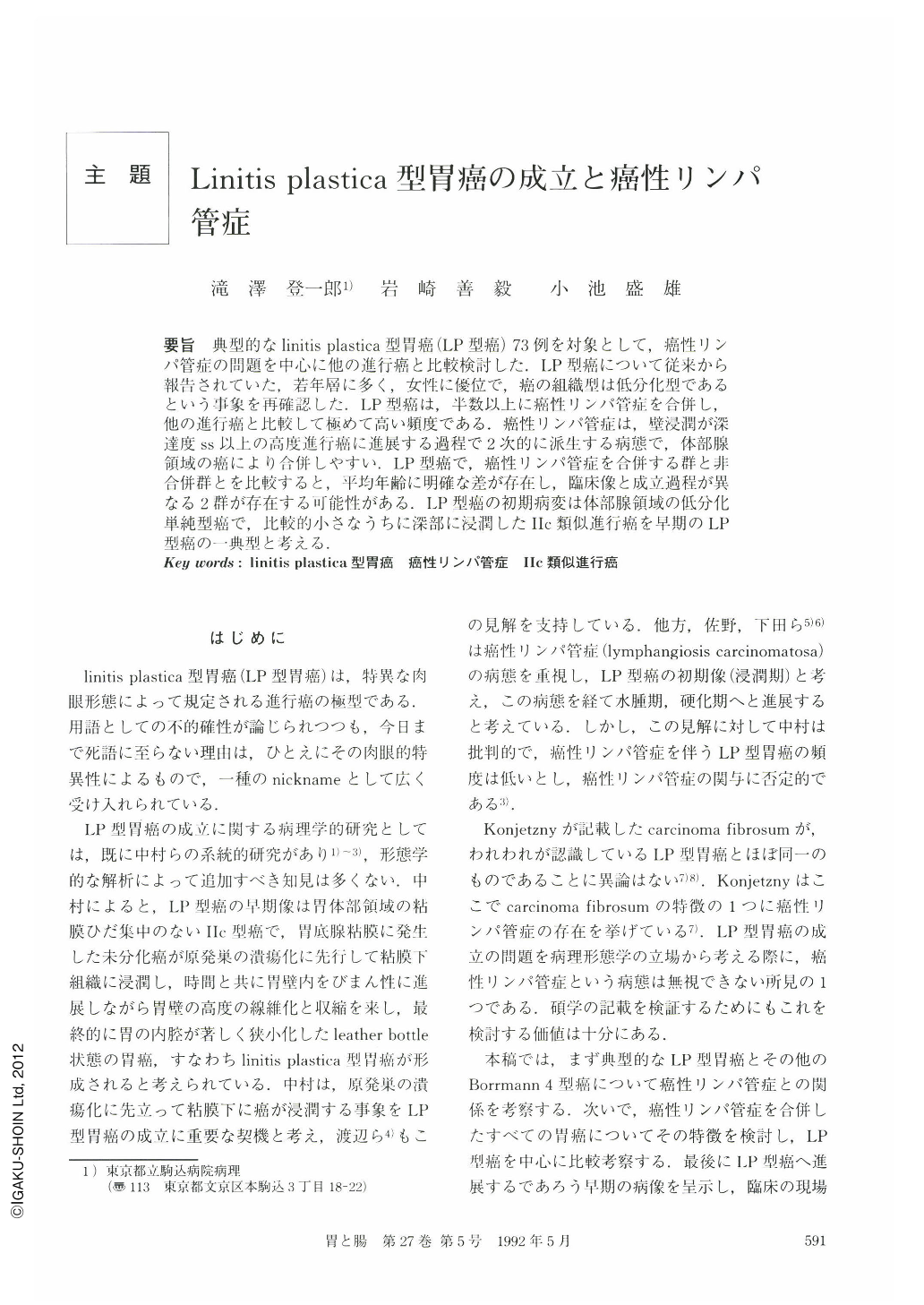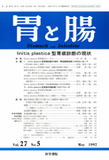Japanese
English
- 有料閲覧
- Abstract 文献概要
- 1ページ目 Look Inside
- サイト内被引用 Cited by
要旨 典型的なlinitis plastica型胃癌(LP型癌)73例を対象として,癌性リンパ管症の問題を中心に他の進行癌と比較検討した.LP型癌について従来から報告されていた,若年層に多く,女性に優位で,癌の組織型は低分化型であるという事象を再確認した.LP型癌は,半数以上に癌性リンパ管症を合併し,他の進行癌と比較して極めて高い頻度である.癌性リンパ管症は,壁浸潤が深達度ss以上の高度進行癌に進展する過程で2次的に派生する病態で,体部腺領域の癌により合併しやすい.LP型癌で,癌性リンパ管症を合併する群と非合併群とを比較すると,平均年齢に明確な差が存在し,臨床像と成立過程が異なる2群が存在する可能性がある.LP型癌の初期病変は体部腺領域の低分化単純型癌で,比較的小さなうちに深部に浸潤したⅡc類似進行癌を早期のLP型癌の一典型と考える.
We examined 1,051 cases of advanced gastric carcinoma, surgically resected at Tokyo Metropolitan Komagome Hospital during the last 10 years. From these, 73 cases of typical linitis plastica type cancer were selected and compared with other type advanced cancers, especially from the aspect of lymphangiosis carcinomatosa. We also examined 245 cases of gastric carcinoma with lymphangiosis carcinomatosa and analysed their characteristic features. The aim of the present study is to clarify the pathologic course of linitis plastica type gastric carcinoma, from the mucosal to the far advanced stage.
Conclusions :
1) The primary lesion of linitis plastica type gastric carcinoma is located in the corpus gland area and it's histologic type is poorly differentiated adenocarcinoma, simplex.
2) Compared with other type advanced cancers, the mean age of linitis plastica type cancer patients is definitely younger and it is much more frequent in females than in males. This has already been reported and confirmed by us.
3) In more than 50% of all cases of linitis plastica type gastric cancer, we could verify the presence of lymphangiosis carcinomatosa. Compared with other advanced cancers, it's frequency rate is extremely high.
4) The pathologic state of lymphangiosis carcinomatosa is closely related to the site of the cancerous lesion and the depth of the cancerous invasion. Lymphangiosis carcinomatosa is more frequently developed in cancers arising from the corpus gland area. In all gastric cancers with lymphangiosis carcinomatosa, more than 96% of them are far advanced cancers with deep invasion beyond the propria muscle layer. Considering the transmural deep cancerous invasion, lymphangiosis carcinomatosa should be considered to be an acquired pathological state.
5) In two groups; linitis plastica type cancers with lymphangiosis and those without lymphangiosis, the mean age was quite different. The mean age of the group with lymphangiosis was obviously younger than the group without lymphangiosis. Two different clinical courses may be assumed to have taken place in each group respectively.
6) Ⅱc-like advanced cancer in the corpus gland area should be regarded as one of the early lesions with potentiality to progress to linitis plastica type cancer.
7) The most important mean for early detection of linitis plastica type cancer is to discover a depressed small cancerous lesion in the corpus gland area and to make an accurate diagnosis concerning the depth of cancerous invasion. In cases of Ⅱc-like advanced poorly differentiated carcinoma with deep transmural invasion, the possibility of lymphangiosis carcinomatosa should be considered.

Copyright © 1992, Igaku-Shoin Ltd. All rights reserved.


